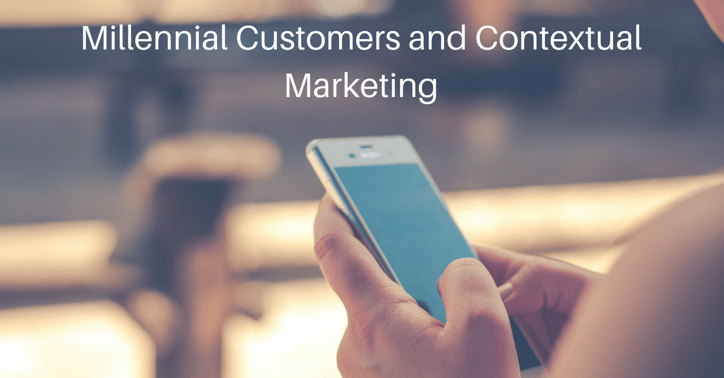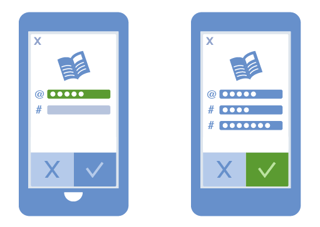There’s been a lot of hype around the millennial generation in the marketing world lately, and for good reason. They’re the largest generation since the Baby Boomers, have an estimated purchasing power of $170 billion per year, and own an average of 7.7 connected devices. Unlike other generations, they grew up connected to everything and everyone, including their favorite brands. However, this doesn’t mean marketing to millennials is easy. In fact, winning the hearts of millennial customers has been a challenge for businesses in across all verticals. So if you want to get the edge over the competition when it comes to millennials, your marketing needs to have context.

What is Contextual Marketing?
Contextual marketing is the creation and distribution of content, paid or unpaid, to people that have showed interest in related topics, or have engaged with similar pieces of content. Also dubbed by the term relevant marketing, this tactic works especially well for millennials as it makes brands more personable.
With 37% of millennials stating they don’t trust big businesses, relevant marketing shifts the focus from making the sale to providing customers with value. It allows millennial customers to easily engage with content as it speaks to their goals, concerns, and opportunities that lie before them on their journey towards a purchase.
A Closer Look at Millennial Customers
Companies everywhere are fighting for the attention (and ultimately wallets) of the millennial generation, but so many of these efforts just aren’t producing the results they want to see. The biggest mistake I see companies make when marketing to millennials is treating them like they’re the same as previous generations. This just simply isn’t true, and is costing them precious time and resources.
Millennials grew up right alongside the internet. They were born into a connected world, and have been constantly adapting to the rapid technological advancements from a young age. They’re used to tuning out tv ads that mean nothing to them. They have no problem flipping past the irrelevant ad in newspapers or magazines (if they even pick it up).
Millennials are spending their time on digital channels instead. Whether they’re checking their social feed for engaging content, checking their email, or browsing the web, they use an average 3.3 connected devices on a daily basis. So if you want to target millennials, traditional just isn’t the way to go. You need to focus your efforts on where they are.
What Millennials Really Want from Businesses
Part of a strong digital marketing strategy is making data-driven decisions. Let’s look at 4 noteworthy stats about millennials so we can get a better idea as to what they engage with, and how we can tailor our approach to better appeal to their needs.
64% of millennials feel that companies should offer more ways to share their opinions online.
It’s no secret that millennials are a socially driven generation. Growing up as social media emerged has allowed them to voice their thoughts and opinions to the world with a few clicks. It’s no surprise that millennials look for social proof when making a purchase. They’ll check product and company reviews to see the value a brand has delivered to someone else, so they can see if that value is relevant to their situation.
Not only will more reviews help millennial customers see the value you provide, but it will
also allow them to voice their own opinions about your products or services. This gives their purchases something every millennial yearns for: purpose.
More than 50% of millennials use their smartphones to research products or services while shopping.

I’d be lying if I said I didn’t do it. I’ll be walking down the aisle of a store and want to know more about a product on the shelf. Instead of finding the closest salesperson to answer my questions (and try to upsell me) I whip out my smartphone and find reviews or a product description page to find the answer myself.
This is normal for millennials. Since they don’t trust big businesses, they’d rather discover the value themselves. This puts the power in the customer’s hands and empowers millennials to make the decision on their own…kind of.
56% of millennials report they would share their location to receive coupons from nearby businesses.
This is a great example of why contextual marketing kills it with millennials. Empowerment is the key to getting engagement from millennials. Optimizing for local search and getting in touch with the consumers that are around you is the first step to getting people into your store. If you can draw them in with a promotion that speaks to the needs they’ve expressed from their engagement, your marketing will perform like it never has before.
216% of millennials are more likely to be influenced by in store touch screen displays.
Ever walk by the Apple store in your local mall and wonder why they’re always packed? It’s because they have plenty of touch screens throughout the store for people to instantly engage and interact with. For millennial customers, it allows them to explore the value their products have on a personal level, instead of branded messages or even social proof.
Touch screens allow customers to interact with a company’s offerings directly, and facilitate discovery. No one wants to be sold, so if you can eliminate unnecessary sales people in the buyer’s journey and replace it with valuable content that has context to the customer, it’ll increase brand awareness as well as brand equity.

User Generated Content
This touches back on using social proof in your marketing strategy, as well as giving your customers a meaningful connection to your brand. User generated content is content that customers have posted online (reviews, social posts, pictures, etc…) and using it on the brand level for promotional purposes.
If you want a good example of UGC, take a look at GoPro’s Instagram account. They average about two posts a day, 1 of which is a featured picture from someone using their product how it was intended. With 12.3 million followers, having your picture as the “GoPro Photo of the Day” will bring excitement and immense brand loyalty.
Meet Them Where They Are
The best way to ad context to your marketing is to understand where your customers are spending their time online. It’s not enough to say that millennials are spending their time online. You need to understand the specifics. What websites do they visit to find information? What social channels are they active on? These questions are extremely important to adding context to your marketing efforts.
If you’re executing an inbound marketing strategy, answers to these questions should be answered in your buyer personas. If not, effectively targeting millennials with contextual marketing is dependent on these answers, and you need to understand their buying process from awareness to consideration, to decision.
Don’t stop after the sale
Ask them how the product worked. If you’re a service-based company, ask them about their experience and what you could do to make it better. Their input will be invaluable to your future marketing efforts and will allow them to make more of a personal connection with your brand.
Ultimately, marketing to millennials is tough. It’s not about targeting them as a whole. You need to do thorough research about who your niche target is and how they buy. This way, you can provide them with the relevant content they’re searching for, and you can empower them to make an educated purchasing decision.





.jpg)